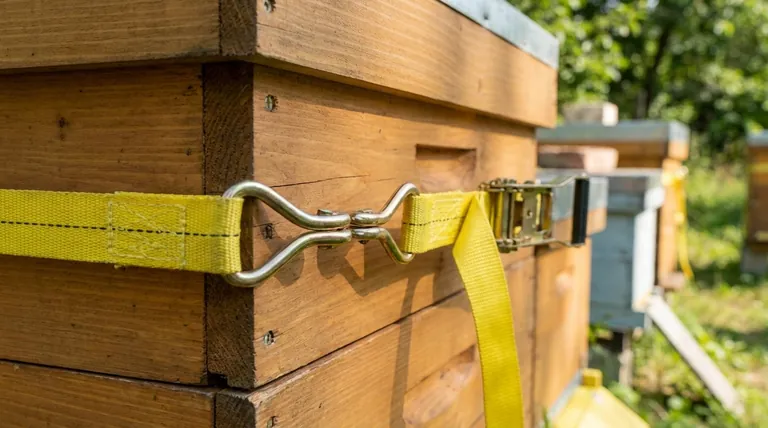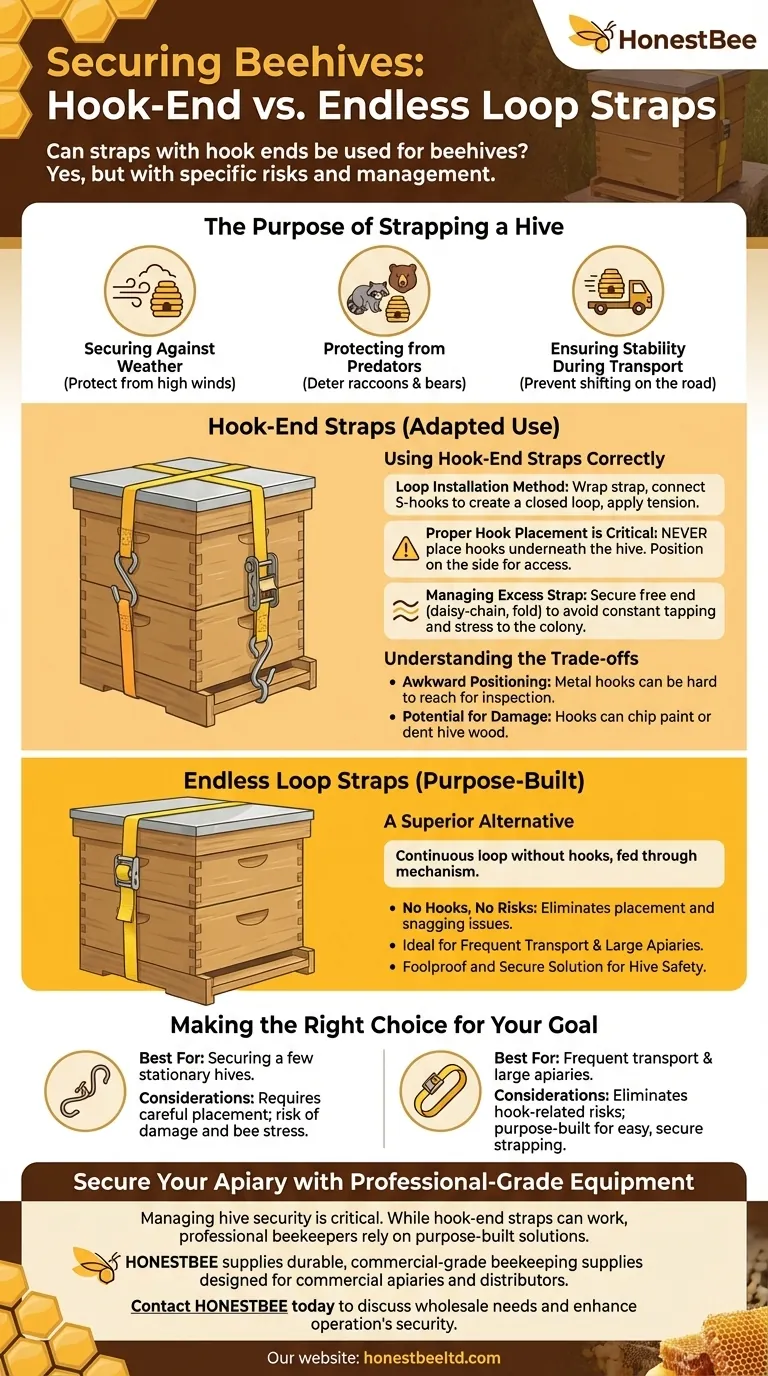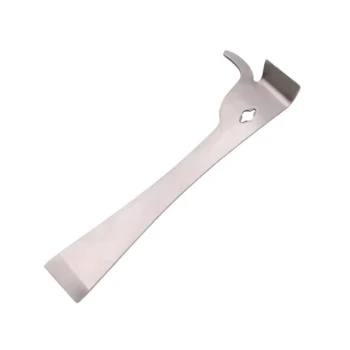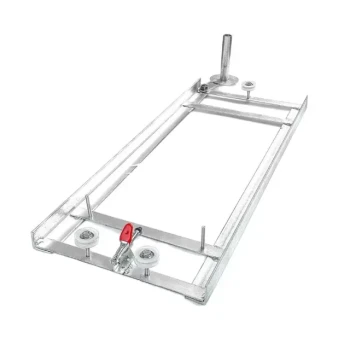Yes, you can use straps with hook ends to secure a beehive. These are typically employed in a loop installation, where you wrap the strap around the hive and connect the two hooks to each other. However, their design creates specific risks that must be managed, as proper placement of the hooks and strap is critical for both hive integrity and the well-being of your bees.
While functional, using hook-end straps for beehives is an adapted use, not their primary design. The core challenge is managing the potential downsides of the hooks themselves—such as placement and potential for damage—to ensure the hive remains secure and the colony undisturbed.

The Purpose of Strapping a Hive
Before discussing strap types, it's essential to understand the primary goals of securing your hive. This context informs which method is best for your situation.
Securing Against Weather
The most common reason to strap a hive is to protect it from high winds. A strong gust can shift or even topple hive bodies, exposing and potentially killing the colony. A strap unifies the hive components into a single, stable unit.
Protecting from Predators
Animals like raccoons and bears are notorious for trying to break into hives. A sturdy strap acts as a significant deterrent, making it much more difficult for predators to pry the boxes apart to access the honey and brood.
Ensuring Stability During Transport
For beekeepers who move their hives for pollination or to new apiaries, strapping is non-negotiable. It prevents the hive components from shifting or separating due to bumps and vibrations on the road.
Using Hook-End Straps Correctly
While not purpose-built for this task, hook-end straps can work well if you follow specific best practices.
The Loop Installation Method
Wrap the strap around the vertical length of the hive. Connect the two S-hooks together to create a closed loop. Once hooked, use the ratchet or cam buckle mechanism to apply firm, even tension.
Proper Hook Placement is Critical
The hooks should be positioned in an accessible location, typically on the side of the hive. Never place the hooks underneath the hive. This makes them nearly impossible to access and safely release tension, especially if the hive settles into the ground.
Managing the Excess Strap
Most hive straps are around 12 feet long, leaving a significant amount of extra material. A loose strap end flapping in the wind can create a constant tapping noise on the hive, which causes significant stress to the colony.
To prevent this, secure the free end by daisy-chaining it, neatly folding and tucking it, or using a simple clothespin to fasten it to the main strap.
Understanding the Trade-offs
Using hook-end straps involves balancing their availability and convenience against a few notable risks.
The Primary Risk: Awkward Positioning
The main drawback is the potential for the metal hooks to end up in a difficult-to-reach spot. If you must unstrap the hive quickly for an inspection or emergency, having the connection point under the hive or tight against a wall is a serious impediment.
Potential for Damage
The metal hooks can chip the paint or dent the wood of your hive boxes if handled carelessly or if the strap shifts under tension. While a minor concern, it can affect the longevity of your equipment.
Comparison to an Endless Loop Strap
A superior alternative for this specific application is an endless loop strap. This type of strap is a continuous loop of webbing without any hooks, fed through a ratchet or cam buckle. It eliminates all the placement and snagging issues associated with hooks, providing a more secure and foolproof solution.
Making the Right Choice for Your Goal
The ideal strapping method depends entirely on your operational needs and priorities.
- If your primary focus is securing a few stationary hives: Hook-end straps are a perfectly viable and economical choice, as long as you are diligent about hook placement and managing the excess strap.
- If you frequently transport your hives or manage a large apiary: Investing in endless loop straps is highly recommended to save time and eliminate the safety risks associated with poorly placed hooks.
- If your absolute priority is hive safety and ease of use: An endless loop strap is the definitive choice, as it is purpose-built for encircling objects and removes potential points of failure.
Ultimately, a properly secured hive is a safe and productive hive, regardless of the specific hardware you choose.
Summary Table:
| Strap Type | Best For | Key Considerations |
|---|---|---|
| Hook-End Strap | Securing a few stationary hives | Requires careful hook placement; risk of damage and bee stress from loose ends. |
| Endless Loop Strap | Frequent transport & large apiaries | Eliminates hook-related risks; purpose-built for easy, secure hive strapping. |
Secure Your Apiary with Professional-Grade Equipment
Managing hive security is critical for colony health and honey production. While hook-end straps can work, professional beekeepers and equipment distributors rely on purpose-built solutions for efficiency and safety.
HONESTBEE supplies durable, commercial-grade beekeeping supplies and equipment designed specifically for the demands of commercial apiaries and distributors. Our wholesale-focused operations ensure you get the reliable gear you need to protect your investment.
Contact HONESTBEE today to discuss your wholesale needs and discover how our equipment can enhance your operation's security and productivity.
Visual Guide

Related Products
- Professional Galvanized Hive Strap with Secure Locking Buckle for Beekeeping
- Endless Loop Ratchet Hive Strap
- HONESTBEE Advanced Ergonomic Stainless Steel Hive Tool for Beekeeping
- Professional Drop-Style Hive Handles for Beekeeping
- HONESTBEE Professional Long Handled Hive Tool with Precision Cutting Blade
People Also Ask
- What are the two styles of hive straps? Choose the Right Strap for Your Hive Security
- What are the types of Emlocks available? Choose the Right Strap for Hive Security
- Why are hive straps important for beekeepers? Secure Your Hives Against Wind, Predators & Transport
- How should a cam buckle strap be installed for optimal performance? Master the Leverage for Maximum Tension
- What is the best length for straps used around beehives? Why 12 Feet is the Industry Standard



















